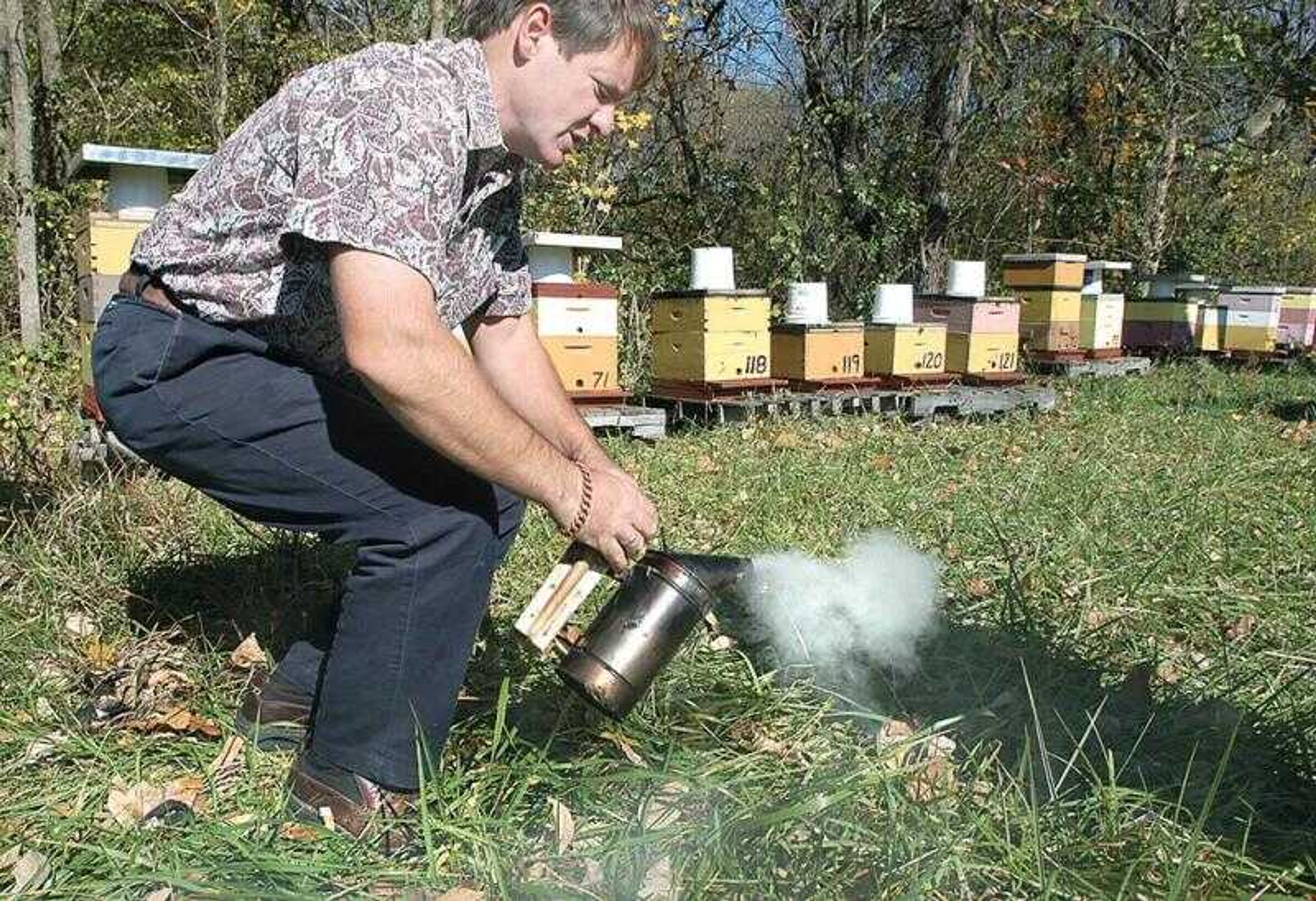By MARK BLISS
Southeast Missourian
Grant Gillard carefully pulls out a wooden frame from a box crowded with bees. The frame, one of several in the box, is covered with a honeycomb.
Even on a cold November day, some of Gillard's bees fly in and out of the entrances to the hives at a grassy site east of Interstate 55 near Fruitland. The box is one of about 120 hives the Jackson man maintains at about 10 sites in Cape Girardeau County.
To the casual observer, it's hard to imagine that the population of America's honeybees has declined.
But a study released this fall by the National Research Council says the declining bee population could damage dozens of commercial crops that depend on the tiny insects for pollination.
American honeybees pollinate more than 90 commercial crops. Bees are the major carrier of pollen for seeded fruit and crops that grow on vines. They're vital to growing everything from apples to zucchini.
But a tiny parasite known as the varroa mite -- beekeepers call it the vampire mite -- practically destroyed the wild honeybee population in the 1990s and is now taking its toll on commercial bee colonies. It's estimated the commercial honeybee population has declined 39 percent since the 1980s.
The small hive beetle also wreaks havoc on the bee population, Gillard said. He estimates that he loses 10 to 20 percent of his hives annually to mites and beetles.
The declining bee population is a major concern to California almond farmers, who need about 1.4 million colonies of honeybees to pollinate 550,000 acres of their trees. By 2012, the state almond farmers are expected to need even more bees as the number of acres of harvest-ready trees grows to about 800,000. It's estimated California almond farmers will need close to 2 million hives to pollinate those trees.
Each year, beekeepers around the country load hives onto 18-wheelers and ship them to the California almond fields. Commercial beekeepers also haul hives to apple orchards and other fruit and vegetable farms around the country.
The National Research Council reported that pollination demands outstripped the domestic supply of honeybees. As a result, U.S. farmers last year had to import honeybees to pollinate their crops for the first time since 1922, according to the Research Council.
"It is getting to be a pretty serious situation," said Neal Bergman, a Kennett, Mo., beekeeper who has the largest operation of any beekeeper in the state. He has about 8,000 hives, each home to about 50,000 bees.
Bergman, who is past president of the Missouri Beekeepers Association, said about 30 percent of his hives are damaged each year by mites and small hive beetles.
Insects aren't the only thing that affect bee populations.
Beekeepers have to be careful about using chemicals to combat the problem because they can hurt the bees.
Drought also can be problem. "Bees require a lot of water to maintain their hives," Bergman said.
On top of that, beekeepers who harvest too much honey can starve their bees.
Each year, Bergman ships about 2,500 to 3,000 of his hives to the California almond fields. "I work strictly with a broker. I just load them on flatbed semis with nets over them," he said.
Bergman's bees spend about a month in California. The pollination season typically runs from mid-February to mid-March.
His honeybees also have worked in the fruit orchards of Oregon, Washington state, Southern Illinois and Southeast Missouri.
Bergman also harvests honey to sell to a major honey co-op. But the growing demand for bees for pollination of crops has become an increasing part of his business, Bergman said.
In California, farmers now pay $130 to $150 to rent a hive for pollination season.
That's not the case locally.
"We are concerned, but I don't think we are significantly affected yet," said David Diebold, co-owner of Diebold Orchards at Benton, Mo., which has apple trees, pear trees and pumpkin fields.
While local orchard owners have taken note of the nationwide decline in the bee population, he said, the area around his orchards seems well populated with bees and has been the last two years.
He has rented bee hives before, though. Diebold said the cost was $15 to $20 a hive.
As for Gillard, the Jackson beekeeper, pollination isn't an issue.
He doesn't rent his hives for pollination. His focus is on honey, and he estimates he harvests about 3,000 pounds of honey from his hives each year. He sells it by the jar to individuals and at a natural foods store in Cape Girardeau.
Gillard, who pastors First Presbyterian Church in Jackson, considers beekeeping a hobby. Though he augments the bees' diet with a mixture of sugar and water, bees require little maintenance.
"I am not really a beekeeper," Gillard said with a smile. "They keep me."
mbliss@semissourian.com
335-6611, extension 123
Connect with the Southeast Missourian Newsroom:
For corrections to this story or other insights for the editor, click here. To submit a letter to the editor, click here. To learn about the Southeast Missourian’s AI Policy, click here.







